Understanding
image sharpness part 2:
Resolution
and MTF curves in scanners and sharpening
by
Norman
Koren
updated
April 18, 2004
In
this page we examine the MTF of
scanners and
sharpening
algorithms, and we address the question, "What scanner resolution
(pixels
per inch or dpi) is required for a digital print to appear sharper than
a conventional darkroom print?"
| Green
is for
geeks. Do you get excited by an
elegant equation? Were
you
passionate about your college math classes? Then you're probably a math
geek— a
member of a maligned and
misunderstood but highly elite fellowship.
The text in green is for you. If you're normal or mathematically
challenged,
you may skip these sections. You'll never know what you missed. |
Scanners
A
scanner samples an image at a spatial resolution
specified by
pixels or dots per inch (dpi) and digitizes each
sample to a
certain
number of bits (which defines tonal resolution),
typically
between
8 and 14. It outputs the image to a file with 24 or 48 bits per pixel
(8
or 16 bits per color). Since good quality scanner sensors are capable
of
more than 8 bits per pixel, some detail is lost in 24 bit color files.
48 bit files retain all the tonal detail captured by the scanner. Not
all
scanner control and image editing programs work with 48 bit files;
Photoshop
and
Picture
Window Pro
are two that do.
You can learn more about film scanners— specifications and a
product
list—
on the Scanners
page.
Now, let's look at actual scanner
resolution, starting with
the
dpi specification. We estimate scanner MTF using mathematical
approximations
that closely match available data.
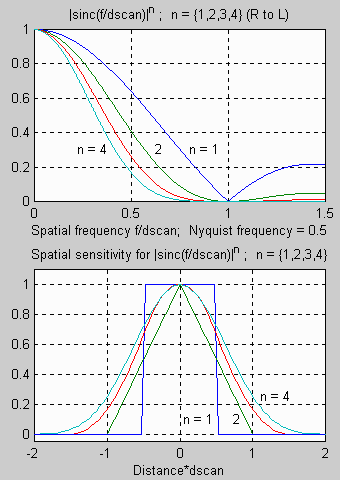 A
typical dedicated film scanner has a characteristic MTF that can be
approximated
by,
A
typical dedicated film scanner has a characteristic MTF that can be
approximated
by,
MTFscan( f )
= |sinc( f /dscan)|3
where
sinc(x) =
sin(πx)/(πx)
if x is nonzero
; sinc(0)
= 1
|...|
denotes absolute value.
Dscan
is the scanner resolution in
pixels per mm;
samples are spaced 1/dscan mm apart. MTFscan(
f
) is the magnitude of the transfer function at spatial
frequency
f.
Since sinc(x) has nulls at x =1, 2, 3, ..., MTFscan(f/dscan)
has nulls where they are expected, at f = dscan, 2*dscan, etc. You can
visualize the null at f = dscan if you realize that
there is
one
complete cycle of the signal, which averages to zero, over sampling
length
1/dscan.
|Sinc( f
/dscan)|3 is
one
of a class of functions of the form |sinc( f
/dscan)|n
that can be used to approximate MTF for scanners and digital camera
sensors
because they are simple, have nulls at the correct frequencies, and
closely
approximate measured data. |sinc( f
/dscan)|n is shown in the
graph on the upper right
for
n
= 1 through 4. The corresponding spatial sensitivity functions are
shown
below. The spatial sensitivity function for sinc( f
/dscan) is
a
rectangle of length 1/dscan (the length of a sensor element with a fill
factor of 1). An "ideal" rectangular sensor with a 100% fill factor
would
have a sinc( f /dscan) response. For n
> 1, the
spatial sensitivity
is the rectangle convolved with itself (n-1)
times. For
sinc2
it is a triangle of length 2/dscan. For large n,
both sincn
and its corresponding spatial sensitivity function approach a gaussian
curve (exp(-k*x2/2)).
Much of the data
for my approximations comes
from
two papers from the Imaging
Technology Research Group of the University of Westminster in
the
UK:
"An
Evaluation
of MTF Determination Methods for 35mm Film Scanners," by S.
Triantaphillidou,
R. E. Jacobson, and R. Fagard-Jenkin, and "A
Novel Approach to the Derivation of Expressions for Geometrical MTF in
Sampled Systems", by R. B. Fagard-Jenkin, R. E. Jacobson, N.
R.
Axford,
both published in PICS
1999: Image Processing, Image Quality, Image Capture, Systems Conference.
In the latter paper, they discuss how sensor response is sensitive to
signal
phase. For signal peaks in the center of an ideal sensor, the MTF
approximates
|sinc( f /dscan)|. But when an average of possible
phases is
taken,
the MTF curve is a good match to |Sinc( f /dscan)|2.
Sinc( f /dscan)|3 is a
better fit to dedicated film
scanners
because of the additional degradation from the scanner optical system
(resolution,
focus and diffraction) and movement. Don Williams, author of
What
is an MTF ... and Why Should You Care?,
has
authored
papers on scanner MTF with data that fits the sinc3
approximation.
Inexpensive flatbed scanners such as the Epson 2450 and the Canon
D2400UF
are not as sharp as dedicated film scanners; their response
approximates
sinc4.
.
| The
Nyquist sampling theorem and aliasing |
| The
Nyquist sampling theorem states that if a signal is sampled at a rate dscan
and is strictly band-limited at a cutoff frequency fC
no higher than dscan/2, the original analog signal
can be
perfectly
reconstructed. The frequency fN
= dscan/2 is called
the Nyquist frequency. For
example, in a digital camera
with
5 micron pixel spacing, dscan = 200 pixels per mm
or 5080
pixels
per inch. Nyquist frequency fN
= 100 line pairs per
mm
or 2540 line pairs per inch. The
first sensor null (the frequency where a complete cycle of the signal
covers
one sample, hence must be zero regardless of phase) is twice
the Nyquist frequency. The sensor's average response (the average of
all
sampling phases) at the Nyquist frequency can be quite large.
Signal
energy above fN is
aliased— it
appears
as artificial low frequency signals in repetitive patterns, typically
visible
as Moiré patterns. In non-repetitive patterns aliasing
appears
as
jagged diagonal lines— "the jaggies." Aliasing is visible in
some of
the
small boxes in this article where bands of high spatial frequency
interact
with the low sampling rate of the monitor screen, roughly 80 pixels per
inch. The figure below illustrates how response above the
Nyquist
frequency leads to aliasing.
| Example
of
aliasing |
|
Signal (3fN
/2) |
|
|
| | |
|
| | |
|
| | |
|
| | |
|
| | |
|
| |
|
Pixels | |
1 |
|
|
2 |
|
|
3 |
|
|
4 |
|
|
5 |
|
|
6 |
|
|
7 |
|
|
8 |
|
|
Response (fN /2) |
|
| | |
| | | | | | | | |
| | |
| | | | | | | |
| In
this simplified example, sensor pixels are shown as alternating white
and
cyan zones in the middle row. By definition, the Nyquist frequency is 1
cycle in 2 pixels. The signal (top row; 3 cycles in 4 pixels) is 3/2
the
Nyquist frequency, but the sensor response (bottom row) is half the
Nyquist
frequency (1 cycle in 4 pixels)— the wrong
frequency. It
is aliased. The
sensor responds
to signals above Nyquist— MTF is nonzero, but because of
aliasing, it
is not good
response. Many
digital camera sensors have anti-aliasing or low-pass
filters
(the same thing) to reduce response above Nyquist. Anti-aliasing
filters
blur the image slightly; they reduce resolution. Kodak
publishes MTF curves for a low
cost anti-aliasing filter. Sharp cutoff filters don't exist
in
optics
as they do in electronics, so some residual aliasing remains. Lens MTF
losses also reduce aliasing. Analog reconstruction is not shown. | Aliasing
from hell. The 14 megapixel Kodak DCS 14n, and its
successors, the
Pro N and Pro C, have no antialiasing filter. MTF response is
outstanding,
but remains high (0.31) at the Nyquist frequency. The 14n behaves very
badly in the vicinity of Nyquist ( 0.5/(7.9 um) = 63 lp/mm. This image
of my MTF test chart
was supplied by
Sergio
Lovisolo. Some of the problem is due to the Bayer sensor: the effective
horizontal and vertical Nyquist frequency for red and blue pixels is
half
that of green. (Diagonals are something else...) The Foveon sensor in
the
Sigma SD9 and SD10 cameras is sensitive to all three colors at each
pixel
site. It also has no anti-aliasing filter and high MTF at Nyquist, but
aliasing is much less visible because it is monochrome, not color. |
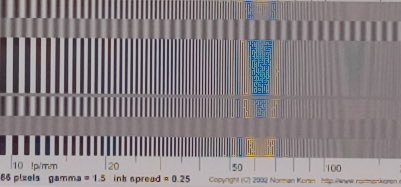 | The
Moiré visible above the Nyquist frequency is evidence that
an
excellent
lens was used to make this image. A little tip: you can achieve
outstanding
resolution with little Moiré with the 14n or its successors
by
stopping
down to around f/16, where diffraction acts as an effective
anti-aliasing
filter. In
all fairness, this aliasing is rarely objectionable in real images,
though
it could show up on fabrics. Kodak has some software solutions The
sensor
manufacturer, Fill Factory,
has an interesting list
of publications including an excellent
paper on this sensor.
To
accurately reconstruct the original analog signal using the Nyquist
theorem,
the samples must be convolved with the strongly oscillating sinc(x*dscan)
function (sinc(x) = 1 for x = 0;
sin(π x) / (π x)
otherwise). This is routinely done in electronic signal processing,
where
high-order sharp cutoff filters are employed. The best known example is
the CD player, with 44,100 samples per second; Nyquist frequency =
22.05
kHz. Response extends to 20 kHz. Unfortunately this can't be done so
easily
with optics. How
the Nyquist theorem actually applies to imaging belongs (in my view) to
the realm of Car
Talk's "Murky
Research." As far as I can tell, the sinc(x*dscan)
function is rarely, if ever, applied. The original signal is never
strictly
band-limited and there is no single means of analog reconstruction.
(Printers
differ from monitors, etc.) Since filters with sharp cutoff don't exist
in optics, there is a severe tradeoff between resolution and aliasing.
The original signal cannot be reconstructed with the same precision as
electronic systems. The
MTF at the Nyquist frequency ( f = dscan/2) for the
sincn( f
/dscan) functions used to approximate the response of digital sensors
is
sincn(1/2) = (2/pi)n
= {0.637,
0.405,
0.258, 0.164 } for n = {1, 2, 3, 4}, respectively.
In imaging
systems
with losses from the film and lens, most aliasing is eliminated in
scanners
with n >= 3. The best flatbed scanners in
Don Williams'
paper had
MTF = 0.3 at the Nyquist frequency— close to the response for
n
= 3. Many digital cameras have optical "anti-aliasing" or "low-pass"
filters
in front of their sensors. These filters spread the light, increasing
the
value of n in the sensor's response. The reduced
aliasing comes
at the expense of resolution. |
|
Given
the difficulty that
optical systems have
in reconstructing the original analog signal, the rule of thumb that
the
number of line pairs per mm a scanner can resolve is less than half its
pixel (or dots) per mm resolution is pretty good. If the Nyquist
theorem could be applied precisely (using sinc(x*dscan)
reconstruction),
it would be very close to half. But in reality you need more than two
pixels
to resolve one line pair of actual image detail (for example, a window
screen). I've seen the number four used as a rough estimate, but that
seems
overly pessimistic in light of the results below. Three seems to be a
pretty
good number, especially when sharpening is applied. Judge for yourself.
Imatest
is a
program that lets you measure MTF and other factors
that contribute to image quality in digital cameras and digitized film
images. It is a valuable tool for learning about scanners and
sharpening.
|
|
Scanner
simulations
| The
curve on the
right
is for a 2400 pixel per inch scan (equivalent to the HP Photosmart S20)
of Velvia film with the excellent 35mm lens, generated
by, MTFcurve2
45
13 61 2 2400/25.4 3
You'll notice a
difference from the
previous images.
The bottom part is full contrast and slanted so we
can see all
sampling
phases. If only one phase were shown, the result might be better or
worse
than average. Slanting the bands allows us to observe aliasing, the low
frequency artifacts that appear when energy above the Nyquist
frequency—
half the sampling rate— is present. Aliasing between the
bands in the
small box and the video screen (roughly 75 pixels per inch) is quite
apparent.
The top of each slanted band has the same tone as the bottom of the
next
band. The
thin magenta curve
is the spatial response of the film + lens prior to scanning. The kinky
red
curve is the spatial response of the scanned image. The thin blue line
is the MTF of the film + lens. The black line is
the MTF of the
film + lens + scanner. The blue
dashed line is the MTF of the scanner only (the
|sinc|3 function). The 50%
and 10% points for MTF are now 27.9 and 44.6 lines/mm,
down
significantly (24% and 35%) from 36.8 and 68.6 lines/mm for the
unscanned
image. | 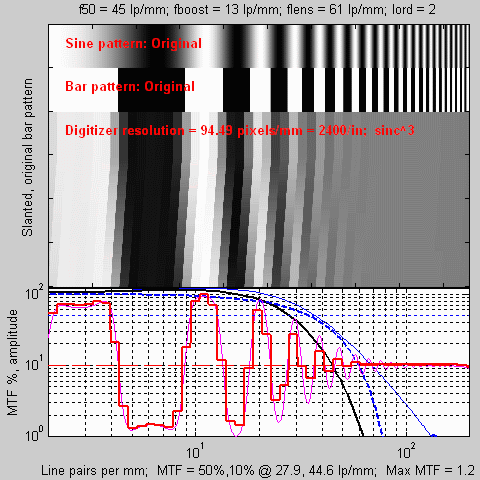 |
| The
curve on the
right
is the result of a 4000 pixel per inch scan (equivalent to the Polaroid
Sprintscan 4000, Nikon 4000 ED or CanoScan
FS4000US) of Velvia film with the excellent 35mm lens.
MTFcurve2
45
13 61 2 4000/25.4 3
The 50% and 10% points for MTF are now 32.7 and
55.4 lines/mm,
down
somewhat less (11% and 19%) from 36.8 and 68.6 lines/mm for the
unscanned
image. Even though the 4000 dpi scanner has 67% more resolution than
the
2400 dpi scanner, the actual scanner resolution is only about 17% to
24%
higher. The image is sharper than the 2400 dpi scan, but the difference
is not dramatic. But we're not done yet.
There's
more to the tale! | 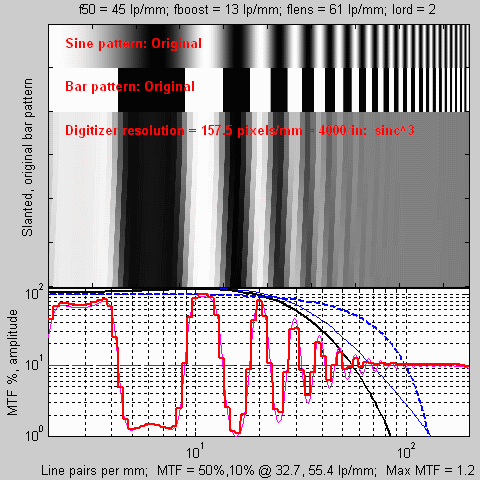 |
Scanner links
R.
N.
Clark's
scanner detail page is required reading for anyone interested
in
image
sharpness. It presents much of the material covered here from a
different
viewpoint: real images.
How
Many Pixels Are
There In A Slide? Ian Porteous' fascinating
comparison of a
very
sharp slide scanned at 2438 dpi, 4000 dpi, and photographed through a
microscope.
He also has some very interesting lens comparisons (Canon 28-70L,
28-105
and primes).
The Research
Libraries
Group, a nonprofit
coalition of universities, libraries, and archives, maintains some excellent
pages. Selecting
a Scanner by Don Williams is extremely informative. What
is an MTF ... and Why Should You Care? by Don Williams is a
valuable
and quite technical introduction to MTF. To probe even deeper, look at
the paper, Diagnostics
for Digital Capture using MTF by Don Williams and Peter D. Burns.
I3A
(the
International Imaging Industry
Association; formerly PIMA) establishes standards for electronic
still picture image quality. The fascinating document, "film
scanner
spatial resolution measurements standard (ISO 16067-2)" is no longer
available
online.
Film
grain and aliasing
P. L. Andrews' impassioned discourse on a much neglected subject that
causes
unexpected image quality degradation.
Electronic
image sensors vs. film: beyond state-of-the-art by B.
Dierickx—
A fascinating technical paper that compared idealized film and digital
sensors.
Kodak
has
some interesting technical
articles on image sensors for scanners and digital cameras.
Their main
image sensor page as links to product descriptions,
specifications
and application notes.
.
View
image galleries .
.
.
An
excellent
opportunity to
collect high quality photographic prints and support this website |
. |
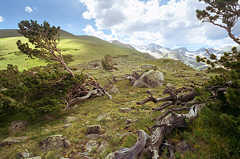 | |
Sharpening
| Sharpening
increases image contrast at boundaries. This
enhances perceived
sharpness and detail, although it doesn't increase actual information
content.
Sharpening can be overdone: too much results in edge artifacts
("halos")
and excessive grain. But the right amount definitely enhances an image.
Although sharpening can be performed during the scan or in the digital
camera, it is usually best done late in the image editing process. A
simple sharpening algorithm subtracts a fraction of two
neighboring
pixels from each pixel, as illustrated on the right. The thin black curve
is the input to the sharpening algorithm: it is the response of the
lens
+ film to a sharp line (impulse
response).
The two thin dashed blue
curves
are
replicas of the input multiplied by -ksharp/2 and shifted by
±1
pixel. The thin red
curve the
impulse
response that results from sharpening— the sum of the black
curve and
the two blue curves, normalized to the same amplitude as the input. The
thick black and red
curves
(shifted
up and left) are the corresponding edge responses before
and after
sharpening.
|
|
The
formula for the simple sharpening algorithm is,
Lsharp(x)
= (L(x) - ksharp/2 * (L(x-V)
+ L(x+V)))
/ (1-ksharp) L(x)
is the input pixel level and Lsharp(x)
is the
sharpened
pixel level. Ksharp is the sharpening constant (related to the slider
setting
scanning or editing program). V is the shift used for sharpening. V
= R/dscan, where R is
the sharpening radius (the number
of pixels between original image and shifted replicas) in pixels.
1/dscan
is the spacing between pixels. The
sharpening algorithm has its own MTF.
MTFsharp( f
) = (1-ksharp * cos(2 π f V ))/(1-ksharp)
This
equation
boosts response at high spatial frequencies. Maximum boost takes place
where cos(2 π f V
) = cos(π) =
-1, or f = 1/(2 V)
= dscan/(2 R). This is equal to the Nyquist
frequency,..fN
= dscan/2, for R = 1 and lower
for R >
1. Actual
sharpening is a two dimensional operation, where
the formula
for
Dsharp can be expressed as a matrix. Click on
this Photo.net
thread for some additional details. The actual sharpening
matrix is
a bit more complex when R is greater than one: it includes additional
terms
for anti-aliasing. |
An
unpleasant side effect
of sharpening is
that
it exaggerates grain and defects such as scratches. Unsharp
mask
is an operation that sharpens the image when the difference between
adjacent
pixels is greater than a specfied threshold. It is used to avoid
exaggerating
grain in smooth areas like skies (masks
are also valuable for this function). The threshold must be set by the
user, and involves an inevitable compromise between enhancing detail
and
boosting grain.
Sharpening
simulations
The image on the right illustrates
the results of
sharpening a 2400 line per inch scan with ksharp = 0.44, generated by,
MTFcurve2
45
13 61 2 2400/25.4 3 .44
| The
thin magenta
curve is the spatial response of the film + lens prior to scanning. The
kinky red
curve is the spatial response of the scanned + sharpened image. The
thin blue
line is the MTF of the film + lens. The black line
is the MTF
of
the film + lens + scanner + sharpening. The dashed blue
line is the MTF of the scanner + sharpening, for R = 1 (V = 1/2400 inch
= 0.0106 mm = 10.6 microns). More detail is visible in the sharpened
image.
This is particularly clear in the image sequence in the Summary below.
Sharpening results in some overshoot at contrast boundaries. This isn't
a problem as long as it's not overdone. It tends to disappear when the
image is printed. The MTF for sharpening (from the above
equation)
has maximum boost at half the scanner resolution ( fN=
dscan/2 = 47.2 lp/mm). Because of the scanner's MTF rolloff, the total
boost is pretty much gone by dscan/2 (50 lp/mm). In the frequency
domain,
sharpening works by boosting response attenuated by the film, lens, and
scanner. A reasonable amount of response must remain for it to be
effective.
In a fuzzy image, there won't be much response left at dscan/2, but you
can still sharpen (though not as much) by setting R (the number of
pixels
between the original image and the replica used for sharpening) larger
than 1, which drops the frequency of maximum boost.
| 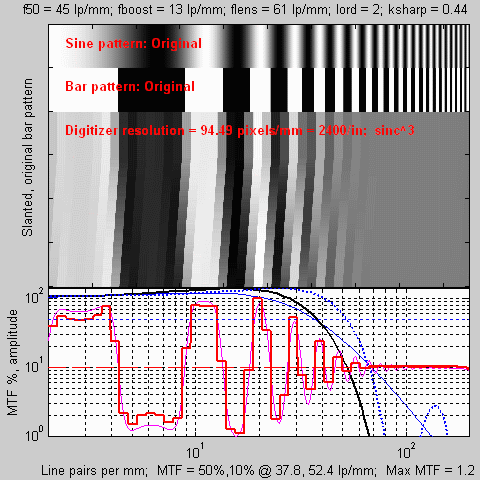 |
The
image on the right shows the results of
sharpening
a 4000 dot per inch scan with ksharp = 0.54. The final result is much
sharper than anything we've seen so far! The difference between the
2400
and 4000 dpi scans is much greater after sharpening. The MTF for the
scanner
+ sharpening (the blue
dashed line) is 50% at approximately 87lp/mm, significantly better than
you'd expect from an enlarging lens (around 50% at 60 lp/mm—
about the
same as an excellent 35mm camera lens). A reason
for the excellent result is that there is still
significant
response for the film, lens, and scanner around the frequency of
maximum
sharpening boost (dscan/2 = 78 lp/mm). Since response for the film +
lens
drops off rapidly above this frequency, increasing the scanner
resolution
above 4000 dpi does little to improve image sharpness. There
is a price to be paid for sharpening: grain and the
effects of
dust and scratches are exaggerated. For this reason, sharpening is
usually
performed with care in the image editing program. "Unsharp mask," which
sharpens only near contrast boundaries, is often employed to avoid
exaggerating
grain.
| 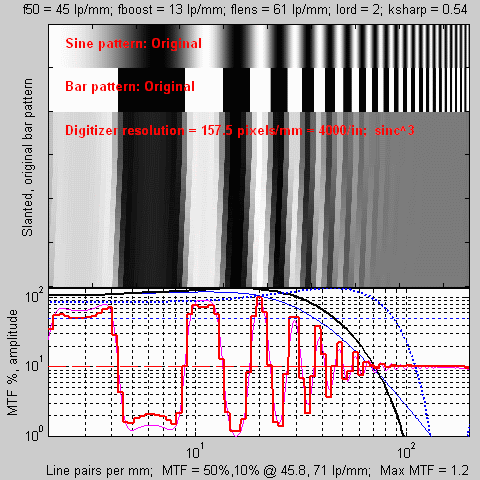 |
[The
sharpening function is identical
to the pulse slimming equalization used in disk and tape drives. Pulses
are sharpened to maximize recording density, but there is an optimum.
Too
much sharpening increases the noise from the disk or tape and
electronics,
degrading performance. Grain is the counterpart of noise in film.]
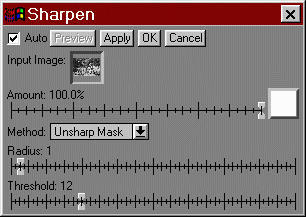 Sharpening
can be performed during scanning or image editing. If you scan at less
than the maximum scanner resolution, you may wish to do sharpening
during
scanning. But sharpening during scanning offers little control. The HP
Photosmart S20 scanner has a slider that controls sharpening, but the
preview
scan image has insufficient resolution to judge its precise
effect— it
can be quite misleading. The default setting is "15." (Could it mean
2*ksharp
expressed in %?) Based on experience I sometimes increase it for older,
less sharp images. But most of the time, if I'm scanning with the S20's
maximum 2400 dpi resolution, I just leave it at the default. I almost
always
do additional sharpening (using Unsharp Mask) during image editing.
Sharpening
can be performed during scanning or image editing. If you scan at less
than the maximum scanner resolution, you may wish to do sharpening
during
scanning. But sharpening during scanning offers little control. The HP
Photosmart S20 scanner has a slider that controls sharpening, but the
preview
scan image has insufficient resolution to judge its precise
effect— it
can be quite misleading. The default setting is "15." (Could it mean
2*ksharp
expressed in %?) Based on experience I sometimes increase it for older,
less sharp images. But most of the time, if I'm scanning with the S20's
maximum 2400 dpi resolution, I just leave it at the default. I almost
always
do additional sharpening (using Unsharp Mask) during image editing.
The
Sharpen transformation control box from Picture
Window Pro provides a good example. When I perform this
function I
enlarge the input and Preview windows to show portions of the images at
1:1 magnification. In this way I can clearly see the effects of
sharpening
as I work. Amount is proportional to ksharp; Radius is R from the
equation,
v = R/dscan— the number of pixels over which
sharpening takes
place.
For 2400 dpi scans I typically set Radius to 1 for images that are
reasonably
sharp to begin with. 4000 dpi scans show up much more detail; an image
has to be exceptionally sharp for me to set Radius to 1. I usually use
2; occasionally 3. Radius needs to be larger for fuzzy images. I prefer
Unsharp Mask to the simple Sharpen transformation because it allows a
decision
threshold to be set: Sharpening only takes place when the difference
between
adjacent pixels is greater than Threshold. This keeps smooth areas like
skies from becoming excessively grainy. I examine different portions of
the preview image for grain and edges. I cut back on Amount if edges
are
oversharpened and increase Threshold if grain is exaggerated in skies
and
smooth areas. I usually make a mask to eliminate sharpening the sky and
other tonally smooth regions.
Digital
vs. conventional darkroom prints
From
Schneider's
enlarging lens MTF data,
f50
for a good enlarging lens appears to be around 60 lp/mm at useable
apertures
of f/8 and f/11— about the same as the excellent 35mm camera
lens. I
haven't
yet added enlarging lenses to the MTFcurve simulation, so I use a
little
shortcut. I observe that f50
for a 4000 dpi scanner alone (without sharpening) is around 60 lp/mm (the
thin blue
dashed line in the unsharpened 4000
dpi scanner
resolution
plot). From this we deduce that conventional darkroom prints
are
about
as sharp as prints made from unsharpened 4000 dpi
scans— at
least
for large prints where the sharpness isn't dominated by printer
resolution. Sharpness for sharpened 2400 dpi scans is
similar. I
confirmed
this when I compared scans of a sharp negative in my report
on
the
Canon
CanoScan 4000 dpi 45mm/APS film scanner. From all this I
conclude...
Prints
from sharpened
4000 dpi scans are significantly sharper than
conventional
darkroom
prints.
I've done a
lot of conventional prints using
rather
fanatic technique, and I can report that a 13x19
inch print of the Aspens
on the
Pitkin
Creek trail near Vail, Colorado, is sharper than any print I
ever
made
conventionally. Very satisfying.
Summary
Modern
high quality inkjet printers, such as the Epson 1270/1280/1290
and
the 2100/2200, are capable of making prints about as fine as the human
eye can resolve at distances of 10 inches (25 cm) or more. We discuss
printers
and prints in parts 3 and 4.
Unlike film, lenses, scanners and sharpening, they can't be modeled
with
neat equations; they have to be measured. A few important points: A
printer's
dots per inch (dpi) rating is not
its true resolution
because
it takes several dots to render a single pixel. At small magnifications
image sharpness is limited by the printer. I'm extremely pleased with
the
intrinsic resolution of my Epson 1270. Prints up to letter size (8 1/2x11
inches) made from sharp 35mm negatives are strikingly clear;
larger
prints are still satisfying, but they tend to be limited by the image
rather
than the printer. 13x19
prints are
pleasingly sharp, but you know they weren't made from 4x5
originals.
The following
images are the piece de resistance
of the
MTFcurve
program: an illustration of resolution at each step of the imaging
process.
The entire plot is normalized for a tonal range from 0 to 1; there is
no
clipping of sharpening overshoots. Since both the film and sharpen
function
oversharpen somewhat (a good thing if not overdone), contrast in other
bands has been reduced. This makes the bands without sharpening
(original,
lens only) look somewhat flat. If I had normalized for each band
individually,
the sharpened bands would appear to have less contrast. For better or
worse,
this is just one of several ways to display the results.
| This
is
the image sequence for Fujichrome Velvia, the
excellent 35mm
lens, a 2400 dpi scan, and sharpening with ksharp = 0.44. The lens is
very
clearly better than the film. The use of Fujichrome Velvia in
these images is not
an
endorsement. Velvia is perceived by many photographers to be one of the
sharpest slide films because of its high contrast and
adjacency
effect
boost. It indeed looks sharper in slides. But in a properly sharpened
scanned
image, Provia 100F (or Ektachrome E100VS, which has an identical MTF
curve)
can be as sharp or sharper— resolution can be boosted with
less danger
of oversharpening. The adjacency effect advantage is lost. Provia 100F
has the additional advantage that it can capture a brightness range at
least one f-stop larger than Velvia. Jonathan
Sachs wrote an excellent article comparing the two. Michael
Reichmann
of Luminous-Landscape
used Provia almost exclusively before he went all digital. See his
comparison, Provia
100F and 400F. | 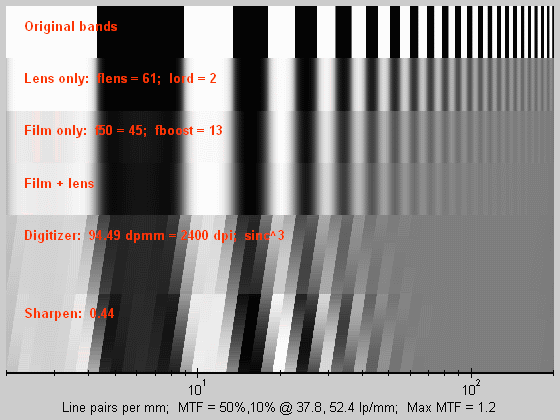 |
| This
image is for a 4000 dpi scan of Velvia with the
excellent 35mm
lens with sharpening constant ksharp = 0.54. (Only the lower part is
shown;
the upper part is identical to the previous image.) Sharpening makes
more
of a visual improvement at this density than it does at 2400 dpi.
Without
sharpening the 4000 dpi scan isn't much sharper than the sharpened 2400
dpi scan. | 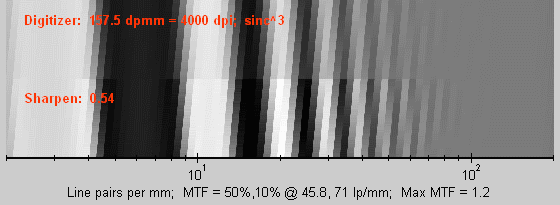 |
The
importance of sharpening is
clearly apparent from these
illustrations.
The sharpening function is one of the great advantages of digital
imaging.
.
| Sharpening
is a vital part of digital image making. It is critical for bringing
out
your image's full potential quality.
|
Additional
observations
- With fine lenses and good technique (sturdy
camera support, etc.), the
sharpness of 35mm color images is limited by the
film. B&W
films,
particularly Kodak T-MAX 100, can be much sharper: image sharpness may
be limited by the lens, but grain is still an issue that affects image
quality.
- Medium
format can be significantly
better than 35mm for two reasons:
(1)
Film is a limiting factor with 35mm, and (2) Photodo's tests show that
medium format lenses are nearly as sharp as 35mm— they have
to cover a
larger area, but they're apparently better designed; they cost a lot
more.
But high
resolution medium
format
scanners are rather expensive— around $3,000. Less
expensive
flatbeds
like the Epson 2450
and Canon
D2400UF
are very good— better than 35mm, but don't take full
advantage of
medium
format. The difference is noticeable only in 16x20
inch and larger prints.
- The
sharpness of large format images
is limited by the lens. Film is
rarely
a factor.
- Sharpening
increases the advantage of
high resolution scanners. For
35mm
format, an unsharpened 4000 dpi scan looks just a little better than a
sharpened 2400 dpi scan. The difference is more pronounced after
sharpening.
- A
photo.net
post comparing film and digital got me curious about the
limits of
35mm— specifically, how much additional detail can you get
with an 8000
dpi scan? I expected diminishing returns beyond 4000 dpi, but an 8000
dpi
scan can have significantly more detail if your slide or negative is
technically
perfect to start with. Click here
is a
comparison
of 4000 and 8000 dpi scans. Unfortunately 8000 dpi scanners
are
prohibitively
expensive.
- I
was happy with the performance of my
HP Photosmart S20 2400 dpi
scanner
for 35mm negatives, but I purchased the 4000 dpi Canon
FS4000US in the summer of 2001. I still use the S20 for
panoramic
images.
In March 2002 I ordered the 2400 dpi Epson
2450 for scanning medium and large format film. The 2400 dpi
Canon D2400F
would have been done the same job. I discuss scanner options elsewhere.
Writing
this has done more to satisfy my curiosity than to change my
photographic
technique, though it gave me the ammunition I needed to purchase a 4000
dpi 35mm scanner. Years ago I had a friend who met Albert Einstein
shortly
before he died. Einstein told him, "Never lose your holy curiosity."
(The
meeting was reported in Life Magazine, May 2, 1955. I finally located
him
with help from the Web.) I was so obsessed with this article during the
month I wrote it (a lot of sleep lost) that I'm not sure if curiosity
is
a blessing or a curse. I just have to accept it..
.
| Download
the MTFcurve program |
The
MTF curve program can be
downloaded by clicking
(or shift-clicking) on MTFcurve2.m.
To run
it
you must have Matlab
installed
on your computer. A $99 student
version is available at campus bookstores. To view
instructions on
running it, type help
mtfcurve2 Examples of running MTFcurve2 from
the Matlab window
have been shown previously. I'd appreciate hearing from you if you
download
and use MTFcurve2. There's no obligation of course, but there aren't
many
of us. |
|
.
Back:
Part 1: Introduction | Part
1A: Film and
lenses
| Next: Part 3: Printers and prints
.
| Equations |
| Varying
frequency The equation for a pure sine wave
tone h(x) (cosine
differs from sine only by a phase of 90 degrees) is,
h(x)
= cos(2 π f x)
where f
is the frequency. This waveform
repeats itself
every 1/f. It would seem logical and intuitive to
use the following
equation
to vary the frequency for the figures in this report. h(x)
= cos(2π f (x) x)
THIS
IS INTUITIVE BUT WRONG!!!
The true definition of frequency
found in communications
textbooks is the rate of change of phase of the function h(x).
For h(x)
= cos(G(x)),
frequency
is defined as f (x) =
1/(2π) dG(x)/dx,
where d/dx is differentiation. Therefore,
G(x)
=
2π ∫ f (x)
dx.
The
result
is quite different from the intuitive but wrong equation above. The
pattern
of black and white tones is created by applying the equation,
round((1+
cos(G(x)))/2)
where round is the Matlab function
that rounds to
the nearest integer, 0 and 1 in this case. Sharpening
The Fourier
transform F
for a function f (x) shifted by
v is, F( f
(x+v)) = F( f
(x)) exp(-2 π j
f v)
For the sharpening equation,
F((Dsharp(x))
= F((D(x)
- ksharp/2*(D(x-v)
+ D(x+v))/(1-ksharp))
= F(D(x))*(1-ksharp
/2 (exp(-2 π j f v)
+ exp(2 π j
f
v)))/(1-ksharp)
where j = sqrt(-1) and cos(x)
= (exp(j x)
+ exp(-j x))/2.
Therefore, MTFsharp(
f
) = F((Dsharp(x))/F((D(x))
= (1 - ksharp cos(2 π f
v))/(1-ksharp)
| |
Zeiss
statement on MTF
I've taken the liberty of reproducing the
following
statement from the archives of Camera Lens News, issue no. 7 (summer
1999),
which I found buried deep within the Carl
Zeiss Camera / Cine Lenses web page. They discuss how most
photographers
misunderstand MTF— my motivation for writing these pages. The
final
paragraphs
are a slam at Schneider Optics, who publish computer simulated MTF
plots
(better than nothing). Zeiss's MTF curves can be found in the Technical
information (PDF files) for individual lenses.
.
| Carl
Zeiss MTF curves are measured – not just calculated |
| The Modulation
Transfer Function (MTF)
is nowadays widely used throughout the optical industry as the
objective
way to clearly represent and evaluate the performance of optical
systems,
like camera lenses for example. Trying to trace
the
usage of MTF in
the optical industry we find first roots dating back as far as the year
1940. At that time an early version of MTF was first applied at Carl
Zeiss
in the Jena factory. Ever since Carl Zeiss pioneered the usage of this
method, being convinced that Zeiss optics compared well by any means,
MTF
included. Other companies in the in-dustry followed decades later. Many
refused to publish MTF data of their lenses arguing that it is not as
easy
as it appears to correctly interpret MTF curves. Today, with the
majority
of lens manufacturers and many photo magazines publishing MTF curves or
similar representations to demonstrate the performance level of camera
lenses, we often encounter cases where the curves are misinterpreted by
enthusiasts quite grossly. Excellent lenses which earned high
reputation
amongst professional users are often underestimated by people who have
no personal experience with the lens, but rely on their own
interpretation
of curves only. The opposite can also be seen: Mediocre optics sell
impressive
numbers, after stunning MTF data was published, albeit users with
personal
experience are rather disappointed.
All
this leads many
seasoned photographers
and practitioners to the question: is MTF really trustworthy? Optics
designers
will be quick to answer "Yes, it is!". They are the ones who can really
interpret MTF curves. They have the professional background and
additional
information helping them to draw the right conclusions from these
curves. They do know, for
instance, that MTF
curves can be influenced significantly, if the spectral energy
distribution
of the light used for measuring or assumed in calculation changes a
bit.
So MTF curves of the same lens coming from different sources may vary,
even when "white light" is specified with all these curves. Even "white
light" is not necessarily the exact same thing unless all the weighing
factors for the different sections of the spectrum are made sure to be
the same. Lens designers
also
know that there
can be a huge difference between a lens performance designed on a
computer
and the actual performance of the real lens once in series production.
This difference is not simply a fixed amount of loss, something like:
"You
design for 95% MTF and you lose 10%, thus getting 85% out of the
production.
So aim a little higher on the design computer and you will get a little
more." Experienced optics manufacturers know that the opposite is
usually
true: If you aim for very high MTF values on the computer you create an
optical system that is extremely sensitive in manufacturing. It will
most
likely force you to lower the MTF specification for final acceptance
significantly
to escape excessive scrapping costs. Thus you may have aimed for 98%
MTF
and get only 70% on average out of production. At least these lenses
show
very impressive MTF curves in the catalogues…
Carl
Zeiss lens
designers may, in a
similar case, tend to rather aim for 93% instead of 98 % in order to
actually
get 90% MTF out of production – with very narrow tolerance
bands. The
MTF
curves that Carl Zeiss publishes, are all measured curves of the first
units actually built – not just calculated plots without
information
about
how well they may be executed by the manufacturer.
As
far as we can see
today Carl Zeiss
is still the only manufacturer to print MTF curves which are measured,
which
describe lenses that can actually be purchased, not just calculated
curves
of highly ambitious designs which may exceed the manufacturer's
capability
of turning them into reality. Camera Lens News
No.
7, summer 1999 |
|
.
Back: Part
1: Introduction | Part 1A:
Film and lenses
| Next: Part 3: Printers and prints

| Images
and text copyright © 2000-2013 by Norman Koren. Norman Koren lives
in Boulder, Colorado, where he worked in developing magnetic recording
technology for high capacity data storage systems until 2001. Since 2003 most of his time has been devoted to the development of Imatest. He has been involved with photography since 1964. |
 |

 A
typical dedicated film scanner has a characteristic MTF that can be
approximated
by,
A
typical dedicated film scanner has a characteristic MTF that can be
approximated
by,


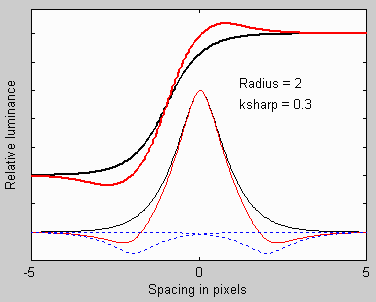


 Sharpening
can be performed during scanning or image editing. If you scan at less
than the maximum scanner resolution, you may wish to do sharpening
during
scanning. But sharpening during scanning offers little control. The HP
Photosmart S20 scanner has a slider that controls sharpening, but the
preview
scan image has insufficient resolution to judge its precise
effect— it
can be quite misleading. The default setting is "15." (Could it mean
2*ksharp
expressed in %?) Based on experience I sometimes increase it for older,
less sharp images. But most of the time, if I'm scanning with the S20's
maximum 2400 dpi resolution, I just leave it at the default. I almost
always
do additional sharpening (using Unsharp Mask) during image editing.
Sharpening
can be performed during scanning or image editing. If you scan at less
than the maximum scanner resolution, you may wish to do sharpening
during
scanning. But sharpening during scanning offers little control. The HP
Photosmart S20 scanner has a slider that controls sharpening, but the
preview
scan image has insufficient resolution to judge its precise
effect— it
can be quite misleading. The default setting is "15." (Could it mean
2*ksharp
expressed in %?) Based on experience I sometimes increase it for older,
less sharp images. But most of the time, if I'm scanning with the S20's
maximum 2400 dpi resolution, I just leave it at the default. I almost
always
do additional sharpening (using Unsharp Mask) during image editing.



